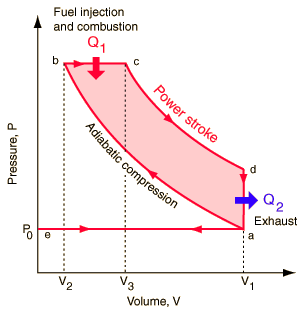How does a 4 stroke diesel engine works?
In the previous article we read about how a 4
stroke petrol engine works. In this article we will know the difference between
the working of the petrol and the diesel engine. When we talk about diesel
engine the spark plug is absent and a fuel injector is present inside the
cylinder block.
The four stroke diesel engine working comprises
of the same four strokes as that of the petrol engine but some part of it is
very different.

A diesel engine is based on the principle of Diesel cycle.
It can be either 2 stroke or 4 stroke. In this article we will see how the 4
stroke diesel engine works.
1.)
Suction Stroke
2.)
Compression Stroke
3.)
Power Stroke
4.)
Exhaust Stroke
The main important parts of the engine are the piston, the
crankshaft, the connecting rod and the cylinder block which includes the
cylinder head. The cylinder head comprises of the rocker arm and spring
mechanism which with the help of a cam controls the opening and closing of the
inlet valve and exhaust valve. The cylinder block is surrounded by water
jackets which helps cooling of the cylinder block. The parts of the cylinder
are shown below.

Suction Stroke (same as that of petrol engine)
The first stroke is suction stroke. In this stroke, the
piston moves from TDC (Top Dead Centre) to the BDC( Bottom Dead Centre), which
are the two extreme most positions of the piston. When the piston moves from
TDC to BDC the inlet valve opens through which fresh charge (atmospheric air +
petrol) is sucked in.
Compression Stroke (same as that of petrol engine but higher temperature-pressure)
The second stroke is the compression stroke in which the
piston moves from BDC to TDC. When the piston moves from BDC to TDC the inlet
valve closes and the charge is compressed thereby increasing its temperature. When
compared to petrol engine the temperature and pressure developed inside the cylinder
block is much higher. To withstand the high temperature-pressure the diesel
engine is bulky and heavier than petrol engine.
Power Stroke
The third stroke is the power stroke which is the most
important stroke in which the piston moves from TDC to BDC. After the compression
stroke the piston is at TDC and this when fuel injector injects or sprays
diesel inside the cylinder block and the temperature-pressure inside the
cylinder block has already risen to great extent during compression which is
enough to ignite the fuel (no need of spark plug). Hence combustion takes place
inside the cylinder block and displaces the piston from TDC to BDC. The main
power of the engine is generated from this stroke. Some amount of power is
stored the flywheel to execute the other three strokes and the rest of the
power is used to drive the wheels of the car. The inlet and the exhaust valves
remain closed.
Exhaust Stroke (same as that of petrol engine)
The fourth stroke is the exhaust stroke in which the piston
moves from BDC to TDC. The hot gases
and the fumes which are generated from
combustion of the charge are pushed out through the exhaust valve which opens
when the piston moves from BDC to TDC.
The Diesel Cycle graph is shown as follows

Constant Pressure
Process: Heat is rejected and received at constant pressure.





0 comments:
Post a Comment